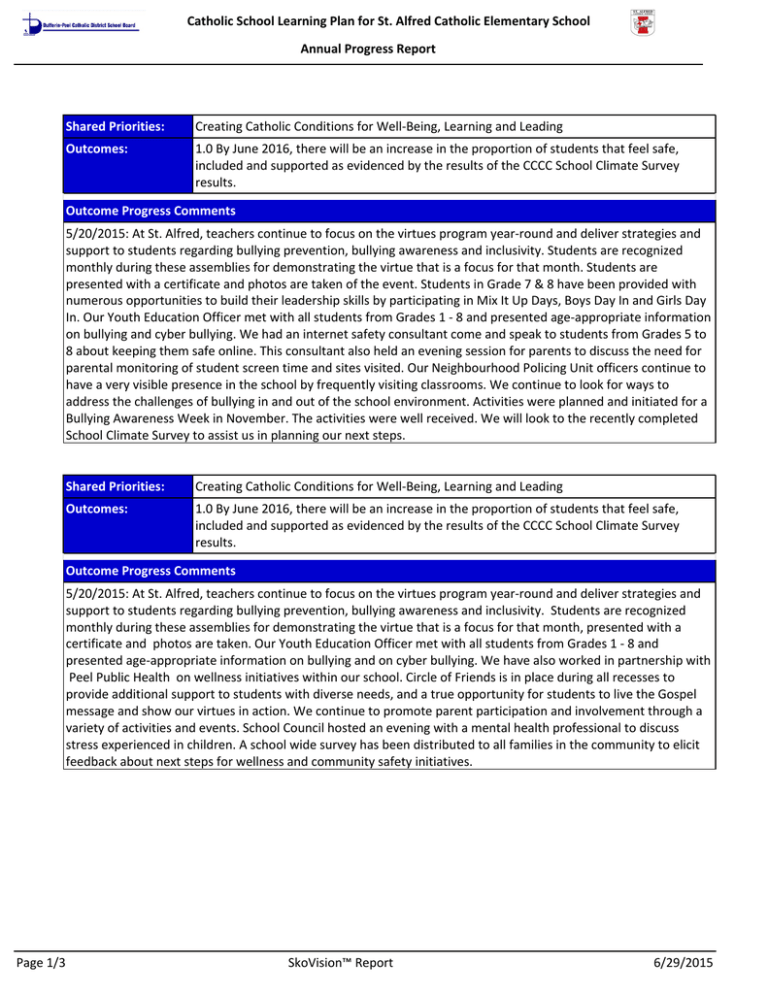Shared Priorities: Outcomes: Creating Catholic Conditions for Well-Being, Learning and Leading
advertisement

Catholic School Learning Plan for St. Alfred Catholic Elementary School Annual Progress Report Shared Priorities: Creating Catholic Conditions for Well-Being, Learning and Leading Outcomes: 1.0 By June 2016, there will be an increase in the proportion of students that feel safe, included and supported as evidenced by the results of the CCCC School Climate Survey results. Outcome Progress Comments 5/20/2015: At St. Alfred, teachers continue to focus on the virtues program year-round and deliver strategies and support to students regarding bullying prevention, bullying awareness and inclusivity. Students are recognized monthly during these assemblies for demonstrating the virtue that is a focus for that month. Students are presented with a certificate and photos are taken of the event. Students in Grade 7 & 8 have been provided with numerous opportunities to build their leadership skills by participating in Mix It Up Days, Boys Day In and Girls Day In. Our Youth Education Officer met with all students from Grades 1 - 8 and presented age-appropriate information on bullying and cyber bullying. We had an internet safety consultant come and speak to students from Grades 5 to 8 about keeping them safe online. This consultant also held an evening session for parents to discuss the need for parental monitoring of student screen time and sites visited. Our Neighbourhood Policing Unit officers continue to have a very visible presence in the school by frequently visiting classrooms. We continue to look for ways to address the challenges of bullying in and out of the school environment. Activities were planned and initiated for a Bullying Awareness Week in November. The activities were well received. We will look to the recently completed School Climate Survey to assist us in planning our next steps. Shared Priorities: Creating Catholic Conditions for Well-Being, Learning and Leading Outcomes: 1.0 By June 2016, there will be an increase in the proportion of students that feel safe, included and supported as evidenced by the results of the CCCC School Climate Survey results. Outcome Progress Comments 5/20/2015: At St. Alfred, teachers continue to focus on the virtues program year-round and deliver strategies and support to students regarding bullying prevention, bullying awareness and inclusivity. Students are recognized monthly during these assemblies for demonstrating the virtue that is a focus for that month, presented with a certificate and photos are taken. Our Youth Education Officer met with all students from Grades 1 - 8 and presented age-appropriate information on bullying and on cyber bullying. We have also worked in partnership with Peel Public Health on wellness initiatives within our school. Circle of Friends is in place during all recesses to provide additional support to students with diverse needs, and a true opportunity for students to live the Gospel message and show our virtues in action. We continue to promote parent participation and involvement through a variety of activities and events. School Council hosted an evening with a mental health professional to discuss stress experienced in children. A school wide survey has been distributed to all families in the community to elicit feedback about next steps for wellness and community safety initiatives. Page 1/3 SkoVision™ Report 6/29/2015 Catholic School Learning Plan for St. Alfred Catholic Elementary School Annual Progress Report Shared Priorities: Building Collaborative Practices Through Inquiry Outcomes: 2.0 By June 2016, through the continued use of collaborative inquiry as a process for learning, all learners will be engaged in building and sharing knowledge as evidenced by collaborative conversations and exit tickets. Outcome Progress Comments 5/20/2015: All teachers are part of a Professional Learning Community, engaged in a school wide professional development on the use of the 3 part Math lesson model, use of manipulatives and reviewing the Ontario Math curriculum expectations. We receive support from our Special Assignment Teacher. The SAT and administrative team work collaboratively to provide staff with support, training, professional readings, as well as engaging them in discussions, sharing and examining data specifically around the 3-part lesson design model and developing growth mind-sets. With the support of our Special Assignment Teacher (SAT) all teachers have the opportunity to plan collaboratively and deliver lessons using the 3-Part Lesson Design Model. All staff are engaged in inquiry based learning through staff meetings and release time. Shared Priorities: Enhancing Transitional Practices Outcomes: 3.0 By June 2016 there will be an increase in the proportion of students who have demonstrated improvement on the learning skill and work habit of self-regulation as evidenced by report card data. Outcome Progress Comments 5/20/2015: School staff will be focusing on a four-phase model for self-regulation to assist students in self-affect learning (e.g., What am I being asked to do? Can I do it? Why or why not?). Their scan identifies resources (e.g., I can use the computer, or get help from my peers), constraints (e.g., I’m feeling distracted today) and opportunities (e.g., the teacher said I can choose a topic that interests me). Second, students set their goals for learning and plan how to approach them. This step is critical. It creates benchmarks for keeping track of how well learning unfolds as it unfolds. Third, students start work and regularly probe it: “Am I on track?” Minor adjustments may be needed to improve how learning unfolds. Their plan may be taking too much time; or perhaps a strategy they chose isn’t working, so a different tactic needs to come into play. Fourth, at major breaks or when the task is completed, the student reviews everything and asks: “How well did that go? What can I do to improve my learning in the future?” Teachers will support students in achieving greater self-regulation. First, by continuing to design learning experiences to provide opportunities for practising each phase of self-regulation. Continuing to create tasks that are complex enough to invite self-regulation but not so beyond students’ skills and abilities that it overwhelms them. Their work will use Vygotsky’s zone of proximal development where, with a bit of help, they can succeed. We will also continue to work clearing out classroom spaces so students have sufficient space to work and play. Page 2/3 SkoVision™ Report 6/29/2015 Catholic School Learning Plan for St. Alfred Catholic Elementary School Annual Progress Report Shared Priorities: Knowing the Learner through Assessment Outcomes: 4.0 By June 2016 there will be an increase in the proportion of students who communicate and represent strategies which support their learning as evidenced by EQAO Questionnaire, formative and summative assessments. Outcome Progress Comments 5/20/2015: Staff continue to develop and use learning goals and co-constructed success criteria as part of regular practice in all classrooms. This is evidenced by the learning goals and success criteria which are posted in all classrooms. Students are engaged in reflecting on their work through the use of descriptive feedback, referencing student produced anchor charts and success criteria which are posted in their classrooms. We will continue to work on providing greater descriptive feedback. Shared Priorities: Responding through Effective Instruction Outcomes: 5.0 By June 2016 there will be an increase in the proportion of students achieving level 3 or 4 on the EQAO assessments. Outcome Progress Comments 5/20/2015: Staff have developed a common understanding of learning goals and related success criteria. Students are using learning goals to support self and peer assessment. Teachers continue to use formative and summative assessment results to guide instruction. Staff have continued to work on enhancing Math instruction within the classrooms by focusing attention on the 3 Part Math lesson model, the use of manipulatives and reviewing the Ontario curriculum to see the developmental progression of expectations. At risk students in Grade 3 & 6 are supported through the After School Tutoring Program. Page 3/3 SkoVision™ Report 6/29/2015



